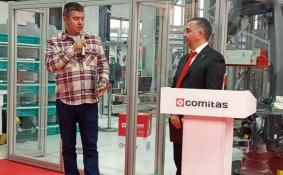Scientific & Practical Journal

Editorial News
Dear readers! We are pleased to present to you the eleventh issue of the journal in 2025. There are a lot of relevant and useful materials in the issue, which, hopefully, will not be ignored.
Dear readers! In September the CeMAT RUSSIA exhibition was held, which showed everyone that innovations and robotics are increasingly penetrating the logistics industry. We can safely say that many technologies are tested here, and only then they go out into the world. However, it is not only CeMAT RUSSIA that demonstrates the prevalence of the digital agenda.
Dear readers! This is the ninth issue of the journal, which turned out to be very rich and diverse. Traditionally, the issue is opened by an analyst. The material by Alina Nasyrova from the Market Guide Agency, dedicated to investments in warehouse complexes in Russia, recalls the importance of developing logistics infrastructure for the integrated development of regions.
PHOTO OF THE WEEK
CITATIONS
All News of Logistics
The decline in retail sales led to vacancy rate growth and fall in rental levels in Moscow shopping centres
Moscow, 21 January, 2016 – According to JLL estimates, vacancy rate on Moscow retail market has reached 8.3%, increasing by 0.8 pp. in Q4 2015 and by 2.3 pp. YoY respectively. The availability has increased due to both high volume of new Moscow retail supply (560,000 sq m in 2015) and active rotation of tenants who are under pressure due to sagging consumer demand.
According to Rosstat, accumulated retail turnover growth in January-November in Russia has reached a level of -9.3% to the corresponding period of the previous year, Moscow’s retail sales were down by 13% YoY over the same period.
JLL estimates that the vacancy rate on Moscow shopping centre market might reach 10% by the end of 2016, which is close to the record-breaking 11% of Q2 2010. “The reasons for the expected growth of vacancy rate in Moscow shopping centres are the negative forecast for retail market dynamics as well as a significant volume of new projects launched their development before the crisis,” – Tatyana Kluchinskaya, National Director, Head of Retail Department, JLL, Russia & CIS, explains. – “Around 460,000 sq m of new quality shopping centres is likely to be completed in Moscow this year, and following the latest market trends, they are to be occupied by average 50-60%”.
“Currently, expansion-oriented retailers enjoy a variety of alternative offers in the existing shopping centres and prefer the malls with clear footfall and predictable sales. The empty spaces of newly-established schemes will be rented out gradually during the first year of operation. In addition, the significant decline in the future supply will support the overall vacancy rate’s contraction in the market in the long term.” - Tatyana Kluchinskaya adds.












